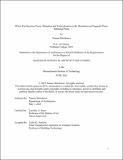When War Becomes Peace: Ruination and Transvaluation in the Hiroshima and Nagasaki Peace Memorial Parks
Author(s)
Shirokawa, Nanase
DownloadThesis PDF (26.76Mb)
Advisor
Jones, Caroline A.
Terms of use
Metadata
Show full item recordAbstract
In postwar Japan, “peace” has become the memorial scaffolding that structures the collective national orientation towards the legacy of the Asia-Pacific War, in large part owing to the devastating bombings of Hiroshima and Nagasaki. Yet the atomic catastrophes endured by the two cities have become subsumed into what Anne McClintock terms the “administration of forgetting.” The traumas associated with the bombs have been construed in Japan as an experience of national victimhood and a moral lesson for humanity, in the process obfuscating histories of imperial terror that I argue are carried forward in significant formal continuities, transvalued in a discourse of peace. Peace, in this regard, becomes a mode for asserting a clean rupture and justifying political amnesia.
Peace is the directive of the memorial landscapes of Hiroshima and Nagasaki, and peacemaking was the process by which ruination became the pretext for social, political, and urban reinvention. The Hiroshima and Nagasaki Peace Memorial Parks, both unveiled in 1955, manifest the ways in which dominant public discourses of peace-making and nuclear remembrance were actualized through the reconstruction of the post-atomic cities.
The processes behind the making of the two parks and their approaches to remembering atomic violence trouble the perception that the memorials are shaped solely by the circumstances of the bomb and the postwar milieu of liberal democracy. These sites, I argue, are intimately informed by a constellation of transwar aspirations. wartime representational practices, bureaucratic tensions, as well as urban and regional histories that span beyond the moment of 1945.
In its dual focus on the spatial narratives of Tange Kenzō’s plan for Hiroshima and the material and bodily politics of Kitamura Seibō’s Peace Statue in Nagasaki, this study also addresses the persistent marginalization of Nagasaki in the discourse of nuclear disaster. A close study of these two sites makes evident the need to take seriously the transmutation and transvaluation of representational modes across shifting regimes. The threat of historical forgetting emerges not only in the absences and forced silences, but also in the adoption of a passive gaze towards our extant memorial infrastructure.
Date issued
2023-06Department
Massachusetts Institute of Technology. Department of ArchitecturePublisher
Massachusetts Institute of Technology